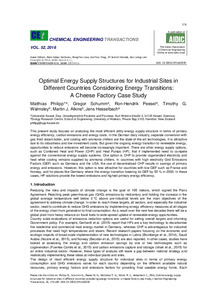Datum
2016Autor
Philipp, MatthiasSchumm, GregorPeesel, Ron-HendrikWalmsley, Timothy GordonAtkins, Martin J.Hesselbach, JensSchlagwort
620 Ingenieurwissenschaften EnergieversorgungPrimärenergieEnergieeffizienzEnergiewendeErneuerbare EnergienEmissionsverringerungKraft-Wärme-KopplungWärmepumpeMetadata
Zur Langanzeige
Aufsatz

Optimal Energy Supply Structures for Industrial Sites in Different Countries Considering Energy Transitions: A Cheese Factory Case Study
Zusammenfassung
This present study focuses on analysing the most efficient utility energy supply structure in terms of primary energy efficiency, carbon emissions and energy costs. In the German dairy industry, separate conversion with gas fired steam boiler, and cooling with ammonia chillers are the-state-of-the-art technologies. It is attractive due to its robustness and low investment costs. But given the ongoing energy transition to renewable energy, opportunities to reduce emissions will become increasingly important. There are other energy supply options, such as Combined Heat and Power (CHP) and Heat Pumps (HP), that if implemented need to compete against the conventional energy supply systems. One option is CHP to provide cogenerated electricity and heat while cooling remains supplied by ammonia chillers. In countries with high electricity Grid Emissions Factors (GEF) such as Germany and the USA, the use of decentralised CHP results in savings of primary energy and emissions. However, this option is less attractive for countries with low GEF such as France and Norway, and for places like Germany where the energy transition lowering its GEF by 50 % in 2030. In these cases, HP solutions provide the lowest emissions and highest primary energy efficiency.
Zitierform
In: Chemical engineering transactions (CEt) Volume 52 (2016) , S. 175-180 ; EISSN 2283-9216Zitieren
@article{doi:10.17170/kobra-202012092471,
author={Philipp, Matthias and Schumm, Gregor and Peesel, Ron-Hendrik and Walmsley, Timothy Gordon and Atkins, Martin J. and Hesselbach, Jens},
title={Optimal Energy Supply Structures for Industrial Sites in Different Countries Considering Energy Transitions: A Cheese Factory Case Study},
journal={Chemical engineering transactions (CEt)},
year={2016}
}
0500 Oax
0501 Text $btxt$2rdacontent
0502 Computermedien $bc$2rdacarrier
1100 2016$n2016
1500 1/eng
2050 ##0##http://hdl.handle.net/123456789/12372
3000 Philipp, Matthias
3010 Schumm, Gregor
3010 Peesel, Ron-Hendrik
3010 Walmsley, Timothy Gordon
3010 Atkins, Martin J.
3010 Hesselbach, Jens
4000 Optimal Energy Supply Structures for Industrial Sites in Different Countries Considering Energy Transitions: A Cheese Factory Case Study / Philipp, Matthias
4030
4060 Online-Ressource
4085 ##0##=u http://nbn-resolving.de/http://hdl.handle.net/123456789/12372=x R
4204 \$dAufsatz
4170
5550 {{Energieversorgung}}
5550 {{Primärenergie}}
5550 {{Energieeffizienz}}
5550 {{Energiewende}}
5550 {{Erneuerbare Energien}}
5550 {{Emissionsverringerung}}
5550 {{Kraft-Wärme-Kopplung}}
5550 {{Wärmepumpe}}
7136 ##0##http://hdl.handle.net/123456789/12372
<resource xsi:schemaLocation="http://datacite.org/schema/kernel-2.2 http://schema.datacite.org/meta/kernel-2.2/metadata.xsd"> 2020-12-23T12:48:57Z 2020-12-23T12:48:57Z 2016 doi:10.17170/kobra-202012092471 http://hdl.handle.net/123456789/12372 eng Urheberrechtlich geschützt https://rightsstatements.org/page/InC/1.0/ 620 Optimal Energy Supply Structures for Industrial Sites in Different Countries Considering Energy Transitions: A Cheese Factory Case Study Aufsatz This present study focuses on analysing the most efficient utility energy supply structure in terms of primary energy efficiency, carbon emissions and energy costs. In the German dairy industry, separate conversion with gas fired steam boiler, and cooling with ammonia chillers are the-state-of-the-art technologies. It is attractive due to its robustness and low investment costs. But given the ongoing energy transition to renewable energy, opportunities to reduce emissions will become increasingly important. There are other energy supply options, such as Combined Heat and Power (CHP) and Heat Pumps (HP), that if implemented need to compete against the conventional energy supply systems. One option is CHP to provide cogenerated electricity and heat while cooling remains supplied by ammonia chillers. In countries with high electricity Grid Emissions Factors (GEF) such as Germany and the USA, the use of decentralised CHP results in savings of primary energy and emissions. However, this option is less attractive for countries with low GEF such as France and Norway, and for places like Germany where the energy transition lowering its GEF by 50 % in 2030. In these cases, HP solutions provide the lowest emissions and highest primary energy efficiency. open access Philipp, Matthias Schumm, Gregor Peesel, Ron-Hendrik Walmsley, Timothy Gordon Atkins, Martin J. Hesselbach, Jens doi:10.3303/CET1652030 Energieversorgung Primärenergie Energieeffizienz Energiewende Erneuerbare Energien Emissionsverringerung Kraft-Wärme-Kopplung Wärmepumpe publishedVersion EISSN 2283-9216 Chemical engineering transactions (CEt) 175-180 Volume 52 false </resource>
Die folgenden Lizenzbestimmungen sind mit dieser Ressource verbunden:
Urheberrechtlich geschützt

